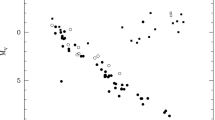Abstract
Nova light curves, plotted on “outburst amplitude-logarithm of main shell radius” axes, have differences that can be systematized. As a result of a survey of over 90 novae, nova groups that are typical in light curve shape have been distinguished: DQ Her, CP Pup, RR Pic, PU Vul, V1974 Cyg, CP Lac, and GQ Mus. The light curve criterion is supplemented by other characteristics. The DQ Her group includes only novae having dust formation in the ejected shell. The GQ Mus group combines certain novae with smooth light curves that are separated into several subgroups with respect to outburst amplitude and the duration of the light curve section before the transitional stage, but for which the linear section of the light curve has the same slope.
Similar content being viewed by others
References
C. Payne-Gaposchkin,The Galactic Novae, North Holland Publ. Co., Amsterdam (1957).
D. B. McLaughlin,Astrophys. J.,95, 428 (1942).
D. B. McLaughlin, in:Stellar Atmospheres, J. L. Greenstein (ed.), Univ. of Chicago Press, Chicago (1961).
H. W. Duerbeck,Publ. Astron. Soc. Pac,93, 165 (1981).
H. W. Duerbeck,Space Sci. Rev.,45, I (1987).
A. E. Rozenbush,Astron. Zh.,73, 598 (1996).
S. van den Bergh and P. F. Younger,Astron. Astrophys., Suppl. Ser.,70, 125 (1987).
M. Hack and L. la Dous, “Cataclysmic variables and related objects,”NASA Spec. Publ., No. 507 (1993).
P. Szkody,Astron. J.,108, 639 (1994).
U. Munari, B. F. Yudin, E. A. Kolotilov, et al.,Astron. Astrophys.,284, L9 (1994).
E. A. Kolotilov, A. M. Tamamikov, V. I. Shenavrin, and B. F. Yudin,Pis ma Astron. Zh.,22, 813 (1996).
O. A. Osminkina, E. Yu. Osminkin, N. I. Shakura, and S. Yu. Shugarov,Eur. Space Agency Spec. Publ., No. 311, 301 (1990).
S. J. Austin, R. M. Wagner, S. Starrfield, et al.,Astron. J.,111, 869 (1996).
M. Della Valle, N. Masetti, and A. Bianchini,Astron. Astrophys.,329, 606 (1998).
J. Bryan, A. Gilmore, R. Whited, et al.,JAPPP Commun., No. 62, 13 (1996).
M. M. Shara, A. F. J. Moffat, and R. F. Webbink,Astrophys. J.,294, 271 (1985).
V. T. Doroshenko, Yu. S. Efimov, and N. M. Shakhovskoi,Pis’ ma Astron. Zh.,21, 580 (1995).
A. E. Rozenbush,Kinemat. Fiz. Nebesn. Tel,4, No. 5, 33 (1988).
H. Sekiguchi, M. W. Feast, A. P. Fairall, and H. Winkler,Mon. Not. R. Astron. Soc,241, 311 (1989).
C. M. Callus, A. Evans, J. S. Albinson, et al.,Mon. Not. R. Astron. Soc,229, 539 (1987).
T. S. Belyakina, N. I. Bondar’, R. E. Gershberg, et al.,Izv. Krym. Astroflz. Obs.,81, 28 (1990).
R. D. Gehrz,Ann. Isr. Phys. Soc,10, 100 (1993).
C. G. Mason, R. D. Gehrz, C. E. Woodward, et al.,Astrophys. J.,470, 577 (1996).
H. W. Duerbeck,Astrophys. Space Sci. Lib.,205, 39 (1995).
Author information
Authors and Affiliations
Additional information
Translated from Astrofizika, Vol. 42, No. 1, pp. 61–74, January–March, 1999.
Rights and permissions
About this article
Cite this article
Rosenbush, A.E. On the possibility of systematizing classical novae by light curve type. I. Type criteria. Astrophysics 42, 43–53 (1999). https://doi.org/10.1007/BF02700913
Received:
Accepted:
Issue Date:
DOI: https://doi.org/10.1007/BF02700913




